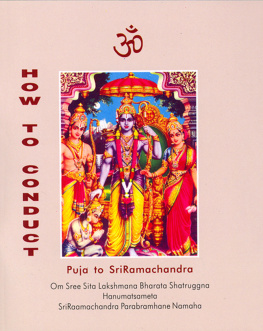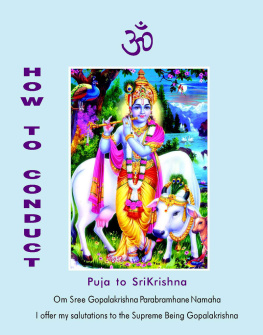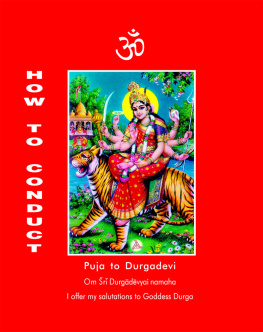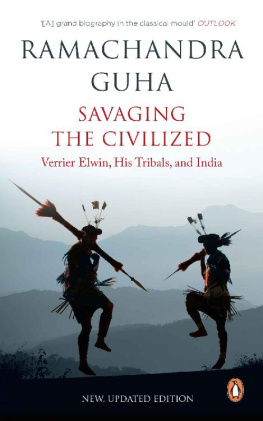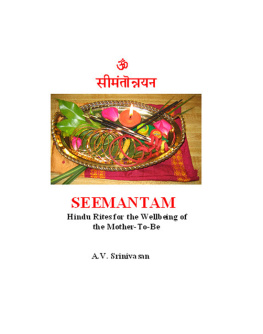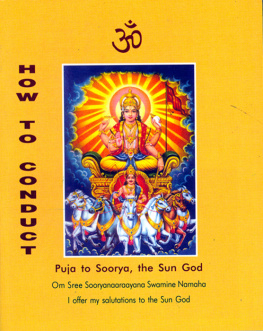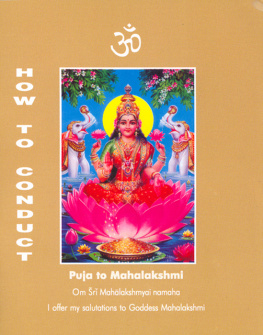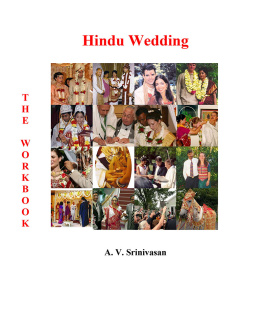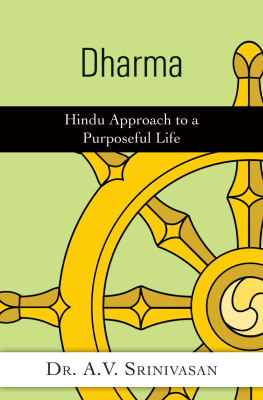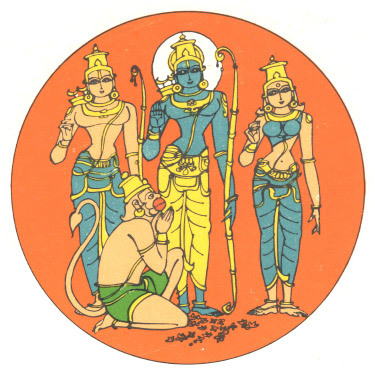
How to conduct
Puja to Ramachandra
in the privacy of your own home in America and in the company of
your family and friends
by
Dr. A. V. Srinivasan
with translation and transliteration
Foreword by Sri. Swami Satchidananda
Om Shri Sita Lakshmana Bharata Shatruggna Hanumatsameta SriRamachandra Parabramhane Namaha
I offer my salutations to the Supreme Being ShriRamachandra in the company of Sita, Lakshmana, Bharata, Shatrugna and Hanuman
A. V. Srinivasan 2000, 2012
No part of this document may be reproduced in any form without prior written permission from the publisher, Parijata Publications c/o Periplus Line LLC, Box 56, East Glastonbury, CT 06025-0056 U.S.A. www.periplusline.com
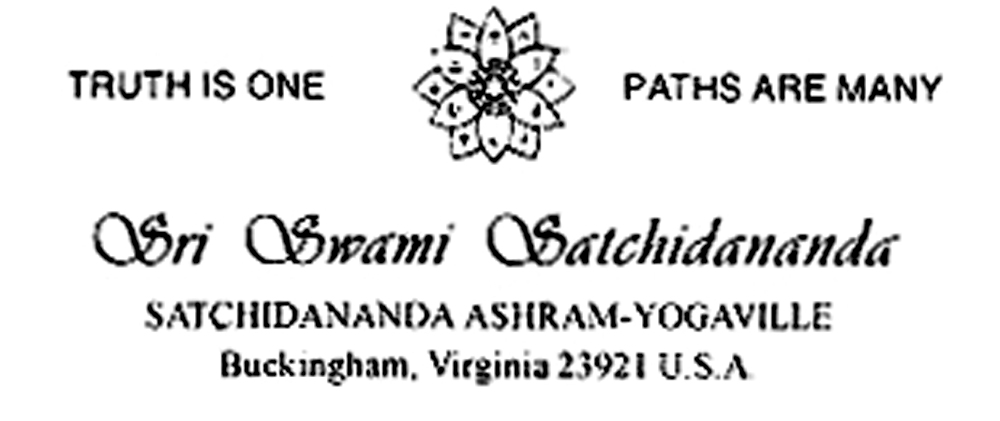
FOREWORD
by Sri Swami Satchidananda
The scriptures tell us that in this modern age, the easiest path to the Godhead is through Bhakti Yoga, the Yoga of devotion. I would say that the most valuable thing of all is to develop intense love for God. Sri Ramakrishna Paramahamsa called this Raga Bhakti or passionate attachment to God. With this kind of bhav you will be able to achieve every and any success in life.
Let us cultivate that raga bhakti through kirtan, japa, puja, and all our spiritual practices. Do whatever is necessary to gain that bhakti, and if you can irrigate the garden of your heart with the waters of bhakti, then there will be no real effort required to develop dispassion. You will be simply transformed by your sincere devotion and communion with God that all the worldly desires, attachments, vasanas, and samskaras will just fall right away.
What good comes of dwelling on ones own faults and flaws? How difficult it may be to overcome through sheer willpower some problem or some attachment? How simple it is to just immerse oneself in the practice of puja and of Bhakti Yoga? As your heart melts in love of God, love toward all and compassion for all beings begins to dawn; ones own selfish desires and preoccupations will fall away.
I am really delighted that our beloved Dr. A.V. Srinivasan has brought forth this wonderful series How to Conduct Puja. Let these booklets inspire you to conduct puja on a daily basis in your home and to impart these traditions to your children. Let us maintain our sacred traditions and spiritual practices because truly they hold the key to peace and success in life. I congratulate Dr. A.V. Srinivasan for his noble efforts and send my best wishes and blessings to all the readers.
OM Shanthi Shanthi Shanthi.

Preface
Worshipping ought to be a personal experience. At the philosophical level, the object of worship is worship itself. Nothing is sought as the end result. However, in order to reach that advanced level, we need to begin and practice praying systematically so that our faith in the Supreme Being is gradually strengthened. To start with, the object of our prayer may be that the Almighty grant us the wisdom to enhance our faith in Him so that we may make a deeper commitment as bhaktas (devotees). Faith is the critical element without which any ritual or religious practice is meaningless. To those who engage in worship of an ishtadevata (Godhead of ones choice), Krishna has an unambiguous warning that is essential for us to note. The message is found in verse 28 of Chapter 17 (Shraddhatraya Vibhaga Yoga) in the Bhagavadgita.
Ashraddhayaa hutam dattam thapastaptham kritamcha yath
asad ithyuchyathe Paarttha na cha thath pretya no iha
Whatever is sacrificed, offered or performed and whatever austerity is practiced without faith, it is falsehood, O Arjuna. And, further, it is of no value either here or hereafter.
We cannot sufficiently emphasize the powerful suggestion that is so easily and so often ignored. Krishnas warning is that we should never engage in a puja ceremony or any other ritual if our heart and mind are not singularly devoted to it. It should not be performed merely because it is the family tradition or it is the right thing to do or to satisfy someone else. The best reason is the most direct and simple reason and that is to surrender to God to seek His protection and pray for inner peace from the eternal conflicts that afflict humanity. Let us simply resolve to pray to Him to grant us the wisdom to have faith in Him and with that faith seek His infinite grace so that we can live a dhaarmic life full of joy and freedom as we serve Him and the society at large.
With faith as foundation, we can begin to develop the practice of worshipping a God/Goddess of our choice. However we need to understand and follow a systematic procedure. Further we need to create an environment in order to immerse ourselves in bhakti. This is precisely the logic in having puja rooms in Hindu households. In the United States and Canada, a new generation of Hindus is growing up and they need some assistance in learning the methods appropriate to their own framework so that they can perform pujas in the privacy of their homes or apartments. A series of these Puja booklets, with Sanskrit transliterations and English translations, are being published to fill this need. These How to Conduct booklets cover all major Hindu festivals with worships to the Sun God Soorya (Makarasankranti), Shiva (Shivaratri), Rama (Sriramanavami), Krishna (Janmashtami), Ganapati (Chaturthi), Durga (Vijayadashami), Saraswati (Vasanth Panchami and Navaratri), Mahalakshmi (Diwali) and Navagrahas. Each booklet begins with an introduction that provides the background in regard to the particular God/Goddess, and includes a step-by-step procedure to prepare an altar, a list of materials needed, preliminary prayers, the worship and conclusion. Thus Hindus can plan a whole year of festivities, perform the pujas and maintain their own tradition.

Table of Contents
Brief Guide to Pronunciation
Since Sanskrit Devanagari lettering and the relevant diacritical marks are not included in the e-version of this book, the guidelines included below cover mainly what is needed to enable the rhythm of the lines to emerge, that is: some vowel sounds and a few consonants:
a = u in hut; aa = a in father; u = u in put; e = e in they; ai = as in eye; o = as in oh; au = ow; c = ch; v = w, except as an initial letter. For the e-book readers convenience, the sound represented in linguistics as c will be kept as ch in the transliteration.
The print version of the booklet contains Devanagari, transliteration with diacriticals and English translation. You may order it through Amazon.com.
Introduction: The Story of Rama
ShriRamachandra is one of the most beloved Hindu Gods and is the hero of our great epic, the Ramayana. Millions of Hindus read the hundreds of stories in the epic and derive immense satisfaction recalling the trials and tribulations the young prince of Ayodhya experienced in the fourteen year exile leading to the slaying of the demon Raavana, recovery of His beloved consort Sita and finally His coronation as the emperor of India of lore. As a story Ramayana is superb. No matter what chapter one reads, one is struck with the depth of human feeling, human nature and the eternal conflicts among values.
Next page
